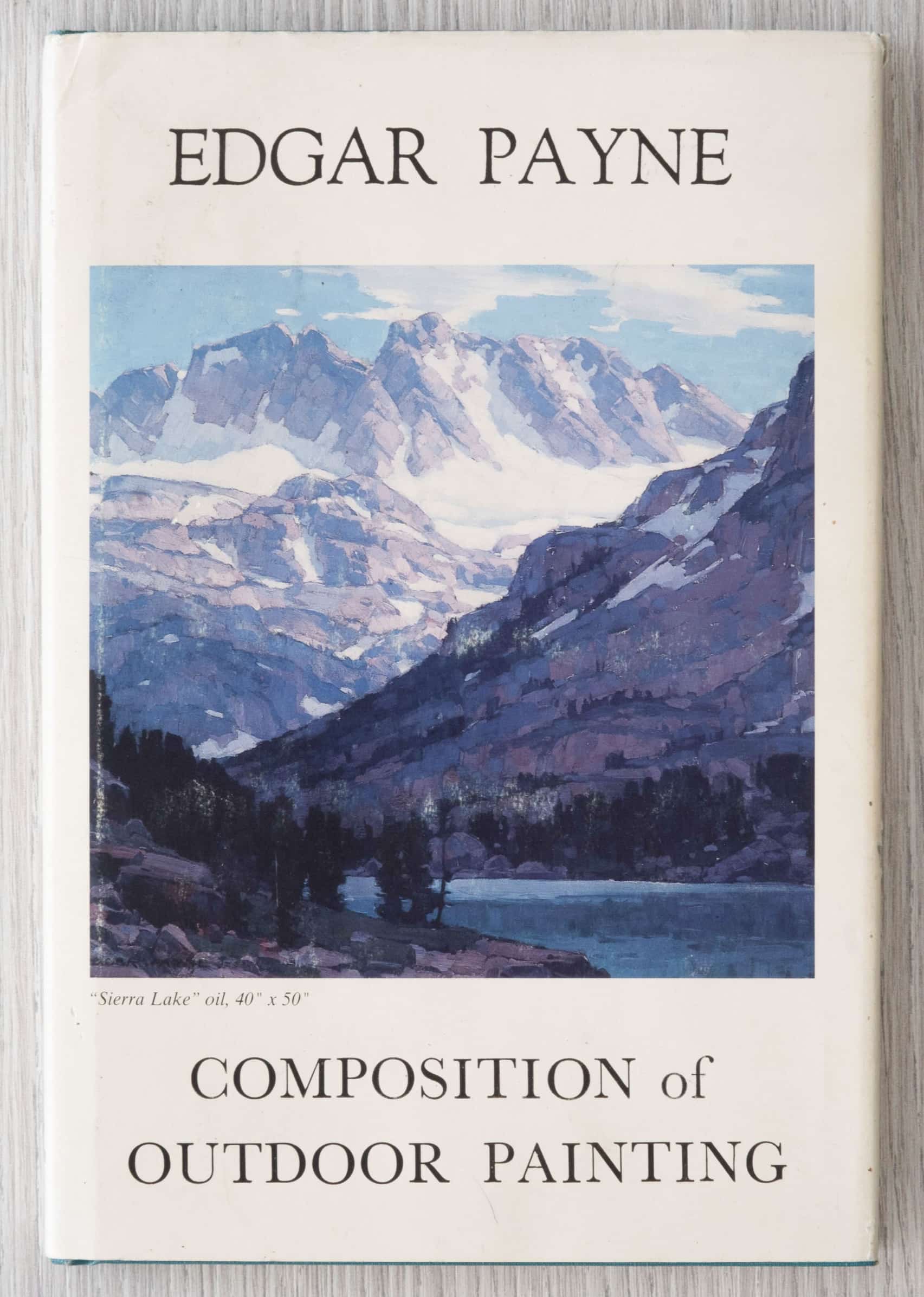June 10, 2022 / Books
Composition of Outdoor Painting by Edgar Payne with
Nathan Sowa
A Book review from The Florence Academy of Art Alumni.

Although published in 1934, Edgar Payne’s Composition of Outdoor Painting is a comprehensive volume on outdoor painting techniques and theory and is still one of the most referenced source materials for landscape courses today!
Born in Barry County, Missouri in 1883, and dying at the age of 64 in 1947, Edgar Alwin Payne was a well known landscape painter of his time, receiving large commissions and painting widely through North America and Europe. His early painting education included enrolling at the School of the Art Institute of Chicago, but Payne left the academy after a couple of weeks and honed his skills and technique through experience as a predominately self-taught artist.
Nathan Sowa, a graduate of The Florence Academy of Art, is one of many contemporary artists that still finds immense value in the book Payne left behind.
Below is an extensive review by Sowa on Composition of Outdoor Painting, where detailed summaries of the contents of the book are provided!
Notes on Edgar Payne’s Composition of Outdoor Painting
American philosopher John Dewey, in his 1934 book Art as Experience, argued that the practice of everything from crafts, trades and science, to art and philosophy, provides opportunities to have aesthetic experience. By aesthetic experience, he means enjoyment derived from assembling disconnected materials and experiences into a coherent, unified whole, where faculties of memory, imagination, and sensory impressions synthesize through artful use of objects and principles.
To compose is to engage in this assimilation and reorganization. For painters such as Edgar Payne, the craft of composing is not only valuable as a means to an end, but is itself a source of happiness and meaningful purpose.
How to think of the terms ‘rules’ and ‘principles’: Any constructive activity relies on fundamental truths. In the case of painting, they could be as simple as blue mixed with yellow giving green, light being heightened by its proximity to dark, or the use of warm tones to enhance adjacent cools of equal value.


Regarding formulas and conventions: Compositional spines like the triangle, circle, steelyard, etc., are so general that they often appear in work that never consciously used them and aren’t overtly apparent. Familiarity with them should ultimately not interfere with instinctive painting, however, and there is always the possibility that a successful design has no reference to them whatsoever:
“The breadth or elasticity of principles gives the artist ample room to exercise artistic freedom and assume authority or the initiative to take hold of each problem and work it out. The power to do this comes from ingenuity and determination, plus knowledge and training. Working out any problem depends on the ability to see errors, mistakes, obstacles or room for improvement. Difficulties, either small or large, are usually traceable to the violation of some major fundamental.”
Further, “Naturalness and ease in depiction should always transcend any over-influence of conventions. The abstraction of the mind from over-influence of any acquired knowledge should be almost complete.”

Practical advice for studying: Study should consist of looking at other paintings, painting from nature, sketching from imagination and nature, purposeful observation, experimentation, and meditation.
He provides an example of Monet painting the same subject 10 or 20 times under different conditions and from different perspectives, as “the practice develops all facilities and creates confidence and sureness. Real advancement generally comes from studying and experimenting with one problem until it is mastered.”


On color: Payne is a fan of the “soup” method:
“Previously mixing a large amount of dominant shade, then injecting it in every color used is sometimes called the “soup” method, but whatever name it is given it is a great help not only in developing taste but in creating harmony… a dark gray made with Indian red, ultramarine blue and a portion of a yellow added makes a very satisfactory dark for the palette. This dark can be modified with other colors to suit the color scheme or with white to suit the value scale.”

On color: Payne is a fan of the “soup” method:
“Previously mixing a large amount of dominant shade, then injecting it in every color used is sometimes called the “soup” method, but whatever name it is given it is a great help not only in developing taste but in creating harmony… a dark gray made with Indian red, ultramarine blue and a portion of a yellow added makes a very satisfactory dark for the palette. This dark can be modified with other colors to suit the color scheme or with white to suit the value scale.”


On color: Payne is a fan of the “soup” method:
“Previously mixing a large amount of dominant shade, then injecting it in every color used is sometimes called the “soup” method, but whatever name it is given it is a great help not only in developing taste but in creating harmony… a dark gray made with Indian red, ultramarine blue and a portion of a yellow added makes a very satisfactory dark for the palette. This dark can be modified with other colors to suit the color scheme or with white to suit the value scale.”
He discusses invented or imposed color schemes, such as using a dominant hue balanced with its compliment: “balance by opposite color adds vitality, interest and picturesqueness to any work. A complete harmony and balance should have a well thought out plan in the proportions of the opposites — an artistic inequality of complementaries with a dominant color, shade or tint throughout. For example, suppose we take yellow and purple combination, use either of these as the largest proportion, then mix a tint of yellow as the dominating vehicle; this brings the purple and all other colors used into the harmony of the yellow. On the other hand, a purple tint may be used, bringing the yellow and other colors to a purplish harmony. In both cases, harmony and balance have been produced. Other opposites may be employed, for example: greenish-yellow and purplish-red; orange-yellow and purplish-blue; or any of the other opposites in the pure color circle.”

Shapes and masses: Shapes should not be repetitive in size, including negative spaces:
“with all the possibilities of artistic leeway in alteration or rearranging, the principle of unequal measures is irrevocable. In any form of composition, the equal shapes or sizes of masses is to be avoided as far as possible. Some forms are difficult to change, for instance, architectural measures are often equal. The thing to do here is to disguise the similarity in form by variety in value or color or softened edges.”


“In all of the reproductions of paintings it may also be observed that a broad simple organization of the masses and spaces is evident. Even where there is much detail or variation these do not disturb the bigness of the main designs. All painters of note realize the importance of simplicity in composition; the subordination of detail, consideration for artistic principles and requirements as well as a respect for outdoor form.”
On style, abstraction: Payne assumes that his audience is interested in what can generally be referred to as representational or realistic art.
For him, without reference to nature or imagination informed by nature, good art cannot be made. He thinks that what we find pleasing in non-representational art is due to the degree to which that art recalls naturally occurring qualities; e.g. Pollock’s conveyance of energy with splashed paint and vibrancy with contrasting tones and color can evoke the image of surf crashing on rocks, or the colorful chaos of a forest floor covered in leaves.
Even so, there is always abstraction happening in translating nature to canvas, and abstract feelings and ideas; ‘mystical’, spiritual qualities should be the aim:
“We say a painting is beautiful, not altogether because of its surface appearance but because of its deeper mysterious qualities that lie beyond definition by man. For art is a capricious and whimsical mistress. She purposely flaunts her visible attractions and cunningly conceals her methods of achieving these. Yet through this disguise she reveals a deeper and more significant charm. She, at the same time, endeavors to thwart any attempt to solve the secret of this fascinating unseen beauty.”

It is expected that, as representational painters, we will be dependent to a large degree on what we observe in deciding what and how we paint.
For those who are interested in more than a literal translation of the visual world, who admit that ambiguity, mystery and intentional re-arrangement and selection can enhance the impact of a picture, tools must be used to enable that purpose. Payne has explored how these tools, instead of being restrictive, in fact increase expressive possibilities.
More about Nathan Sowa
Nathan Sowa is an academically-trained artist working in the tradition of impressionist and realist painting. His education includes four years at The Florence Academy of Art in Italy, as well as further studies in landscape painting with Ben Fenske and Marc Dalessio, and workshops with Tom Hughes, Eric Jacobsen, and Adrian Gottlieb. Nathan has taught, mentored, and led numerous workshops and long-term, atelier-style classes. His paintings and drawings have been shown in various galleries and exhibitions in Europe and the U.S.
Nathan is driven by a constant desire to improve his craft. He’s always studying great art, reading books on composition and design, and experimenting with different techniques, mediums, and processes. He believes that a high degree of technical mastery can facilitate artistic expression, but that techniques are not fixed and codified ways of constructing a painting. The variety and limitless technical possibilities in painting are a source of constant inspiration for him.
Nathan seeks to share his love for natural beauty through the medium of fine art. When he’s not painting, Nathan can often be found exploring the landscapes of the Pacific Northwest.











